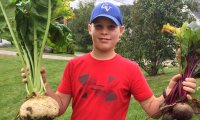Collaboration in Personalized Learning
Vermont educators are working on models of personalized learning that are built around relationships and connected to community needs.
Your content has been saved!
Go to My Saved Content.We’ve seen personalized learning in the news a lot lately. In some cases, communities express concern that students are working independently on screens for hours at a time. Yet it strikes us that personalized learning needn’t—and in fact shouldn’t—come at the cost of social connections and collaborative opportunities. Personalized learning should be both personal and social.
Many Vermont schools are demonstrating how learning can be both customized to individual interests and inherently collaborative, particularly when educators know their students well, design flexible pathways for their students to explore, and value and assess learning well beyond the school day and building.
Learning Who Students Are
Personalizing learning requires teachers to get to know their students well. In Vermont, one of the ways educators are doing this is by inviting them to reflect on questions about themselves: Who am I? What defines me as a person and a member of my community? What do I like to do, and what do I do well? What do I want to do with my life after high school?
At Lamoille Union Middle School, we’ve seen learners delve into this kind of identity work, writing “Where I’m From” poems based on George Ella Lyon’s poetry. Students couple their poems with images and share them with others. At Montpelier Main Street Middle School, learners explore identity in relation to others, as they draw relationship webs that identify key connections with extended family, teams, or other individuals or groups.
In both cases, students include these artifacts in their personalized learning plans, which serve as windows into who they are and what they care about. Their teachers learn more about them, and use this knowledge to build relationships, foster a sense of community in their classrooms, and plan relevant and engaging curriculum. We see in this an important blend of personal and social.
Designing Flexible Pathways
Knowing students well helps teachers create flexible pathways for those students to demonstrate learning. Flexible pathways are at the heart of making learning personal, and Vermont teachers are finding that project-based learning, service learning, experiential learning, and similar approaches invite learning of personal and social significance.
Cabot School’s service learning and leadership program is one example: Students apply for a job with a mentor within the school or community, based on their interests and on authentic community needs. On the culinary team, students learn how to manage a kitchen, working with the school chef to feed their peers and provide food for community events and fund-raisers, which creates a sense of connection and purpose.
Up the road at Burke Town School, students use the United Nations’ Sustainable Development Goals to map their town’s assets and identify individual and collective interests. One student group has created public murals in support of mental health and wellness, another has built a community garden, and still another has set up mountain biking trails on the school campus.
In these schools, students are not only learning vital skills—they’re contributing to the health and well-being of their schools and communities. And they’re doing so based on their interests, as educators make space in the curriculum for learning of personal and social significance.
Valuing and Assessing Students’ Learning
While flexible pathways are engaging for students, they can make assessment tricky. It’s a lot easier when all students respond to the same prompt, take the same test, or perform the same experiment. Assessing personalized learning, in contrast, often means valuing a wide range of authentic evidence of knowledge and skills.
Vermont educators are tackling this challenge by involving students directly in the assessment process. Students in Shelburne Community School’s physical education class, for example, choose an area of fitness that interests them, set goals related to transferable skills, and self-assess their progress by compiling evidence and mapping their growth. Along the way, teachers provide regular formative assessment.
These teachers make sure students have a vision of what success looks like, clear feedback on where they are and what they need to do to improve, and opportunities to engage meaningfully in assessing and sharing their learning for real purposes.
A Statewide Effort
In each of these schools, students know their voices and actions matter. Across the state, we see more and more students engaging in deeper learning experiences like these, about issues they care about—issues that matter in their daily lives and in their communities. When personalized learning is more than solely individual, online learning, we see that:
- Students feel that their work is not disposable,
- Students see themselves as competent,
- Students create work that has an audience beyond the teacher, and
- Students contribute in powerful ways to their communities.
In most of these cases, technology plays an important role in student learning. Yet its use is distinctly different from the self-paced, online curriculum that is rightfully concerning to families. Instead, in these examples, technology serves as a creative tool that students use to connect with peers and to create and deepen meaningful work.
These are the environments we explore, through research and examples from the field, in our new book with John Downes, Personalized Learning in the Middle Grades, based on our work with more than 50 schools in Vermont. Our students have rich lives that are important and should be connected, validated, and celebrated through opportunities to share, connect, and feel a sense of purpose.
When co-designed by teachers, students, and educational leaders, personalized learning can be rooted in relationships, community, identity, and shared purpose. Personalization that validates students’ lived experiences, connects them to their communities, and puts them in the driver’s seat is possible. Learning is powerful when it’s both personal and social.
